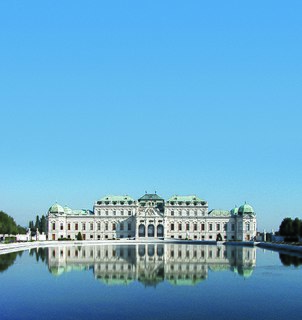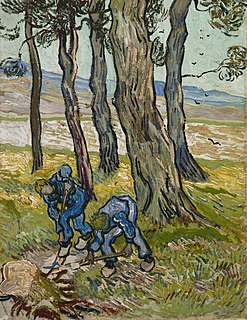
Egon Leo Adolf Ludwig Schiele was an Austrian Expressionist painter. Gustav Klimt, figurative painter of the early 20th century, was a mentor. His work is noted for its intensity and its raw sexuality, and the many self-portraits the artist produced, including nude self-portraits. The twisted body shapes and the expressive line that characterize Schiele's paintings and drawings mark the artist as an early exponent of Expressionism.

The Österreichische Galerie Belvedere is a museum housed in the Belvedere palace, in Vienna, Austria.

Nazi plunder was the stealing of art and other items which occurred as a result of the organized looting of European countries during the time of the Nazi Party in Germany. The looting of Polish and Jewish property was a key part of the Holocaust. The plundering was carried out from 1933, beginning with the seizure of the property of German Jews, until the end of World War II, particularly by military units which were known as the Kunstschutz, although most of the plunder was acquired during the war. In addition to gold, silver, and currency, cultural items of great significance were stolen, including paintings, ceramics, books, and religious treasures.

The Leopold Museum, housed in the Museumsquartier in Vienna, Austria, is home to one of the largest collections of modern Austrian art, featuring artists such as Egon Schiele, Gustav Klimt, Oskar Kokoschka and Richard Gerstl.

Franz Friedrich 'Fritz' Grünbaum was an Austrian Jewish cabaret artist, operetta and popular song writer, actor, and master of ceremonies whose art collection was looted by Nazis before he was murdered in the Holocaust.
Rudolf Leopold was an Austrian art collector, whose collection of 5,000 works of art was purchased by the Government of Austria and used to create the Leopold Museum, of which he was made director for life. Claims had been made by Jewish survivors of the Holocaust that some of the pieces in the collection were Nazi plunder and should be returned to their rightful owners.

Portrait of Wally is a 1912 oil painting by Austrian painter Egon Schiele of Walburga "Wally" Neuzil, a woman whom he met in 1911 when he was 21 and she was 17. She became his lover and model for several years, depicted in a number of Schiele's most striking paintings. The painting was obtained by Rudolf Leopold in 1954 and became part of the collection of the Leopold Museum when it was established by the Austrian government, purchasing 5,000 pieces that Leopold had owned. Near the end of a 1997–1998 exhibit of Schiele's work at the Museum of Modern Art in New York, the painting's ownership (provenance) history was revealed in an article published in The New York Times. After the publication, the heirs of Lea Bondi Jaray, to whom the work had belonged before World War II, contacted the New York County District Attorney who issued a subpoena forbidding its return to Austria. The work was tied up in litigation for years by Bondi's heirs, who claimed that the painting was Nazi plunder and should have been returned to them.

Karl Mayländer was an Austrian art collector and businessman who was deported in 1941 from Vienna to Łódź, in German-occupied Poland, by the Nazis and later murdered in the Shoah.
Jane Kallir is an American art dealer, curator and author. She is co-director of the Galerie St. Etienne in New York, which specializes in Austrian and German Expressionism as well as self-taught and “outsider” art. Kallir has curated exhibitions for many American and international museums and is the author of the catalogue raisonné of Egon Schiele’s work in all mediums.
Galerie St. Etienne is an Expressionism art gallery operating in the United States, founded in Vienna in 1923 by Otto Kallir as the Neue Galerie. Forced to leave Austria after the 1938 Nazi invasion, Kallir established his gallery in Paris as the Galerie St. Etienne, named after the Neue Galerie's location near Vienna's Cathedral of St. Stephen. In 1939, Kallir and his family left France for the United States, where he reestablished the Galerie St. Etienne on 46 West 57th Street in New York City. The gallery still exists, run by Otto Kallir's granddaughter Jane and Hildegard Bachert on 24 West 57th Street. It maintains a reputation as a principal harbinger of Austrian and German Expressionism to the US.

Otto Kallir was an Austrian-American art historian, author, publisher and gallerist. He was awarded the Silbernes Ehrenzeichen für Verdienste um das Land Wien in 1968.
The General Government was the German zone of occupation in Poland after the invasion by Nazi Germany and the Soviet Union in 1939, at the start of World War II. The General Government represented the middle portion of occupied Poland, with originally the West being under German control and the East under Soviet control. The basis for this split was to eliminate the Polish state and to turn all Polish nationals as stateless subjects, disregarding international law.

The Diggers or Two Diggers is an oil painting by Dutch artist Vincent van Gogh painted in late 1889 in Saint-Rémy-de-Provence, France. It is in the Detroit Institute of Arts (DIA), Detroit, Michigan, United States. The Diggers is sometimes called Two Diggers among Trees to distinguish it from The Diggers , 1889.

Dämmernde Stadt is an oil painting by Egon Schiele, a townscape of Krumau, completed in 1913. It also known as Die kleine Stadt II. It was owned until 1930 by Elsa Koditschek, a Jew who survived the Holocaust hidden in Vienna. The painting was taken from her during the Nazi regime. It was auctioned in 1950 at the Dorotheum in Vienna, and bought by a private collector. In 2018, it was auctioned in New York in an act of voluntary restitution, and the proceeds were shared by the descendants of both owners.

Dead City III is an oil on wood expressionist painting by Egon Schiele from 1911. It was owned by the Viennese cabaret artist Fritz Grünbaum before he was murdered by Nazis and has been the object of high-profile disputes and court battles. Suspected by New York's District Attorney of having been looted by the Nazis, Dead City III was temporarily confiscated from the Austrian art collector Rudolf Leopold after he loaned it to a New York museum in 1998. The ownership history of the painting has been the object of high-profile court cases in which two very different versions of the painting's journey from the Jewish Holocaust victim to the Austrian art collector collide.
Serge Sabarsky was an art collector and art dealer of the 20th century.
Lea Bondi, later Lea Jaray or Lea Bondi-Jaray was an Austrian art dealer and art collector who was forced to emigrate to Great Britain due to Nazi persecution after the annexation of Austria to the Nazi German Reich. The Würthle Gallery, which she ran, was "Aryanized" by Nazis and her art collection, including the Portrait of Wally by Egon Schiele, extorted.
Heinrich Rieger was an Austrian dentist whose art collection was one of the most important in Austrian modern art. Rieger and his wife were murdered in the Holocaust.
Daisy Hellmann (1890-1977) was a Viennese art patron and collector persecuted by the Nazis because of her Jewish ancestry.
Friedrich Maximilian Welz was an Austrian art dealer and Nazi party member investigated for art looting.











